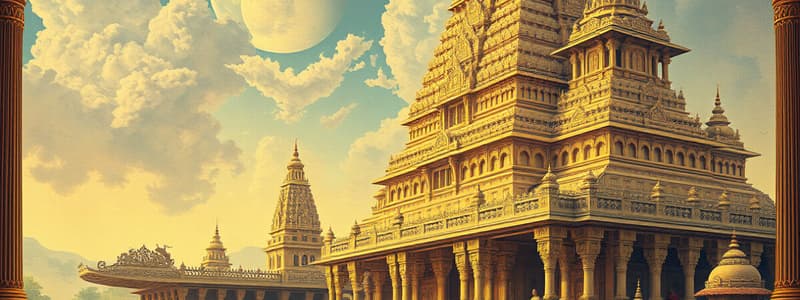Podcast
Questions and Answers
Who was the first king of the Varman Dynasty to conduct the Aswamedh ritual?
Who was the first king of the Varman Dynasty to conduct the Aswamedh ritual?
Mahendra Varman
What significant achievement did Mahendra Varman accomplish against the Gupta army?
What significant achievement did Mahendra Varman accomplish against the Gupta army?
He waged a successful war against the Gupta army.
What was Bhuti Varman known for regarding land donations?
What was Bhuti Varman known for regarding land donations?
He donated lands to more than 200 Brahmanas.
Which regions were incorporated into the Kamrupa kingdom during Bhuti Varman's reign?
Which regions were incorporated into the Kamrupa kingdom during Bhuti Varman's reign?
Why is Bhaskar Varman considered a legendary ruler?
Why is Bhaskar Varman considered a legendary ruler?
Who honored Bhaskar Varman during a conference in Kanauj?
Who honored Bhaskar Varman during a conference in Kanauj?
What was the outcome of the alliance between Bhaskar Varman and Harshavardhana?
What was the outcome of the alliance between Bhaskar Varman and Harshavardhana?
Which famous Chinese traveler stayed at the court of Bhaskar Varman?
Which famous Chinese traveler stayed at the court of Bhaskar Varman?
What does the Assamese Calendar (Bhaskarābda) commemorate?
What does the Assamese Calendar (Bhaskarābda) commemorate?
Study Notes
Mahendra Varman (470-494 CE)
- Eighth ruler of the Varman Dynasty, notable for his leadership and military accomplishments.
- First king of the Varman Dynasty to perform the Aswamedh ritual, symbolizing royal authority and sovereignty.
- Led Kamrupa in a successful campaign against the Gupta Empire, emerging victorious over its army.
- Credited with liberating the Varman Dynasty from Gupta hegemony, marking a significant shift in regional power dynamics.
Bhutivarman (518-542 CE)
- Known as Maha Bhuti Varman; expanded the kingdom significantly through military conquests in Bengal.
- Donated lands to over 200 Brahmins at the borders of Assam's Karimganj district and Bangladesh, promoting settlement and cultural exchange.
- Brahmana settlers primarily originated from Bengal and partially from the Maithila region, contributing to the region's demographic changes.
- His reign witnessed the integration of large parts of North Bengal and Bihar into the Kamrupa kingdom.
- Descendants of these migrants are now recognized as the modern-day Bengalis in Assam's Barak Valley, northern Tripura, and the Sylhet region of Bangladesh.
- The Nidhanpur copper plates housed in Dhaka museum provide historical evidence of these events and settlements.
Bhaskar Varman (594-650 CE)
- Regarded as the last and most distinguished ruler of the Varman dynasty, leaving a lasting legacy.
- Achieved recognition from Harshavardhan, a prominent contemporary ruler, who honored him at a significant conference in Kanauj.
- During Bhaskar Varman's reign, Kamrupa emerged as a major political force on the Indian subcontinent.
- Collaborated with Harshavardhana to defeat the Bengal ruler Sasanka, effectively forcing him to flee to Orissa, illustrating military prowess and strategic alliances.
- Hosted Chinese traveler Hiuen Tsang at his court, leading to cultural exchanges and contributing to historical records of the period.
- The Assamese calendar (Bhaskarābda) commenced from the time of Kumar Bhaskar Barman's ascension, indicating the importance of his reign in the historical timeline of Assam.
Studying That Suits You
Use AI to generate personalized quizzes and flashcards to suit your learning preferences.
Description
Explore the significant contributions of Mahendra Varman and Bhutivarman, two pivotal kings of the Varman Dynasty. Discover their military campaigns, cultural impacts, and how they altered the power dynamics in ancient India. Test your knowledge on their reigns, the Aswamedh ritual, and the expansion of the Kamrupa kingdom.




